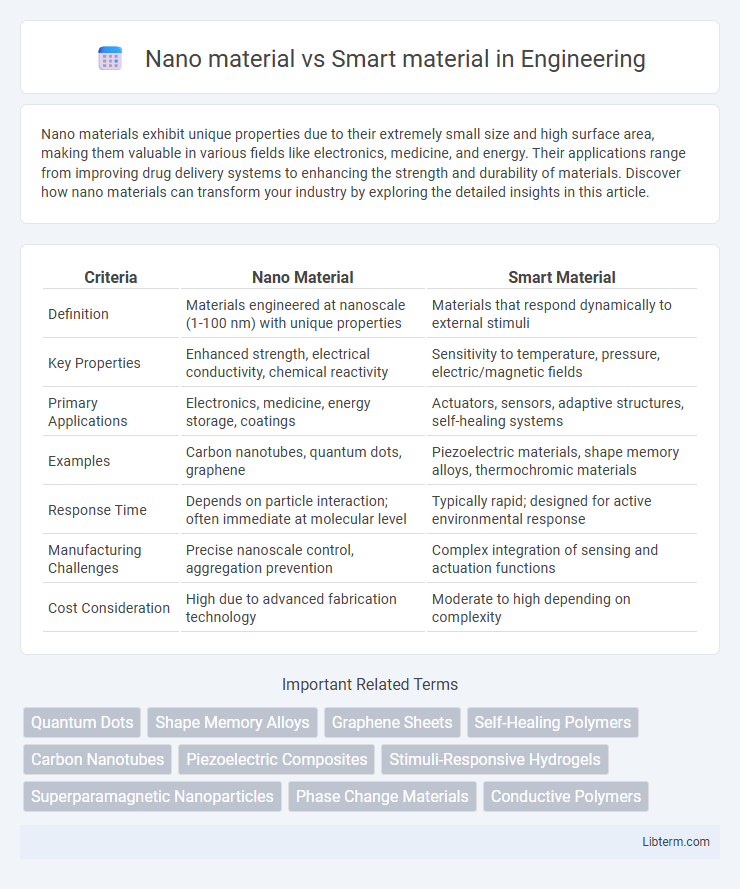Nano materials exhibit unique properties due to their extremely small size and high surface area, making them valuable in various fields like electronics, medicine, and energy. Their applications range from improving drug delivery systems to enhancing the strength and durability of materials. Discover how nano materials can transform your industry by exploring the detailed insights in this article.
Table of Comparison
| Criteria | Nano Material | Smart Material |
|---|---|---|
| Definition | Materials engineered at nanoscale (1-100 nm) with unique properties | Materials that respond dynamically to external stimuli |
| Key Properties | Enhanced strength, electrical conductivity, chemical reactivity | Sensitivity to temperature, pressure, electric/magnetic fields |
| Primary Applications | Electronics, medicine, energy storage, coatings | Actuators, sensors, adaptive structures, self-healing systems |
| Examples | Carbon nanotubes, quantum dots, graphene | Piezoelectric materials, shape memory alloys, thermochromic materials |
| Response Time | Depends on particle interaction; often immediate at molecular level | Typically rapid; designed for active environmental response |
| Manufacturing Challenges | Precise nanoscale control, aggregation prevention | Complex integration of sensing and actuation functions |
| Cost Consideration | High due to advanced fabrication technology | Moderate to high depending on complexity |
Introduction to Nano Materials and Smart Materials
Nano materials exhibit unique properties due to their nanoscale dimensions, significantly enhancing strength, electrical conductivity, and chemical reactivity compared to bulk materials. Smart materials possess the ability to respond dynamically to environmental stimuli such as temperature, pressure, light, or magnetic fields, enabling adaptive and self-healing functionalities. Both nano materials and smart materials are pivotal in advancing technologies across electronics, healthcare, aerospace, and environmental applications through tailored performance at micro and nanoscale levels.
Defining Nano Materials: Structure and Properties
Nano materials possess structures sized between 1 and 100 nanometers, resulting in unique physical and chemical properties such as increased surface area, quantum effects, and enhanced mechanical strength. These materials exhibit distinct behaviors compared to their bulk counterparts due to their nanoscale dimensions. In contrast, smart materials respond dynamically to external stimuli like temperature, light, or magnetic fields but are not strictly defined by their size, emphasizing functionality over nanoscale structure.
Understanding Smart Materials: Characteristics and Functions
Smart materials exhibit the unique ability to respond dynamically to external stimuli such as temperature, pressure, or electric fields, enabling adaptive changes in their properties. Their characteristics include self-healing, shape memory, and sensory functions, which empower applications in aerospace, biomedical devices, and robotics. Unlike nanomaterials that emphasize size-dependent properties at the nanoscale, smart materials integrate responsive behavior to enhance functionality and efficiency in advanced technology systems.
Key Differences Between Nano Materials and Smart Materials
Nano materials exhibit unique physical and chemical properties at the nanoscale, primarily due to their high surface area-to-volume ratio and quantum effects, enabling enhanced strength, reactivity, and electrical conductivity. Smart materials respond dynamically to external stimuli such as temperature, pressure, or electric fields, allowing applications in sensors, actuators, and adaptive devices by changing their shape, color, or other properties. The key differences lie in the scale of functional mechanisms--with nano materials driven by nanoscale structural manipulation and smart materials by their ability to sense and adapt to environmental changes.
Applications of Nano Materials in Modern Industries
Nano materials revolutionize modern industries with applications in electronics, healthcare, and energy by enhancing strength, conductivity, and reactivity at the molecular level. They improve battery efficiency, enable targeted drug delivery, and provide superior coatings with antimicrobial properties, outperforming traditional smart materials. Industries such as aerospace, automotive, and biotechnology rely heavily on nano materials to develop lightweight, durable, and highly functional products.
Innovative Uses of Smart Materials Across Sectors
Smart materials exhibit unique responses to external stimuli, enabling transformative applications in sectors such as healthcare, aerospace, and construction. Shape memory alloys facilitate minimally invasive surgeries, while piezoelectric materials enhance aerospace sensor systems and adaptive building facades improve energy efficiency. These innovations underscore the growing adoption of smart materials in creating responsive, efficient, and sustainable technologies.
Advantages and Limitations of Nano Materials
Nano materials offer superior mechanical strength, enhanced chemical reactivity, and increased surface area compared to smart materials, enabling advanced applications in electronics, medicine, and energy storage. Their nanoscale size allows for precise control over physical and chemical properties, but challenges include potential toxicity, high production costs, and difficulties in large-scale manufacturing. Despite limitations, nano materials drive innovation with unique properties that smart materials may not achieve at the molecular level.
Benefits and Challenges of Smart Materials
Smart materials offer adaptive responses to environmental changes, enhancing applications in aerospace, biomedicine, and robotics with improved efficiency and functionality. Benefits include self-healing properties, shape memory, and environmental sensing, enabling innovative solutions that reduce maintenance and increase system longevity. Challenges involve high production costs, complex material design, and limited durability under extreme conditions, which restrict widespread adoption and scalability.
Future Trends in Nano and Smart Material Technologies
Future trends in nano and smart material technologies emphasize enhanced multifunctionality and improved energy efficiency, driven by advancements in nanostructured composites and stimuli-responsive polymers. Integration of artificial intelligence with nano and smart materials enables real-time adaptive responses, significantly impacting sectors like healthcare, electronics, and environmental monitoring. Research priorities also include sustainable synthesis methods and scalability to facilitate widespread commercialization and eco-friendly applications.
Choosing Between Nano Materials and Smart Materials: Factors to Consider
Choosing between nano materials and smart materials depends on application-specific requirements such as size, functionality, and environmental responsiveness. Nano materials offer advantages in strength, conductivity, and surface area at the atomic scale, ideal for electronics and biomedical uses. Smart materials provide adaptive properties like shape memory or self-healing, suited for dynamic environments needing real-time response.
Nano material Infographic

 libterm.com
libterm.com